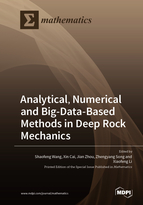Analytical, Numerical and Big-Data-Based Methods in Deep Rock Mechanics
A special issue of Mathematics (ISSN 2227-7390). This special issue belongs to the section "Engineering Mathematics".
Deadline for manuscript submissions: closed (31 July 2022) | Viewed by 45568
Special Issue Editors
Interests: rock mechanics; geomechanics; geomaterials
Special Issues, Collections and Topics in MDPI journals
Interests: rock mechanics; rock dynamics; fracture; rock-water Interaction
Special Issues, Collections and Topics in MDPI journals
Interests: rock mechanics; mining; tunneling; supervised learning; machine learning; metaheuristic algorithms; predictive modeling; rockburst; blasting
Special Issues, Collections and Topics in MDPI journals
Interests: geotechnical engineering; mining engineering
Special Issues, Collections and Topics in MDPI journals
Special Issue Information
Dear Colleagues,
With the increasing requirements for energy, resources and space, numerous rock engineering projects (e.g., mining, tunnelling, underground storage, geothermal and petroleum engineering) are more often being constructed and operated in large-scale, deep underground and complex geology environments. Meanwhile, more and more unconventional rock failures and rock instabilities (e.g., rockbursts, large-scale collapse and mine earthquake) occur and severely threaten the safety of underground operation. It is well recognized that rock has multi-scale structures from minerals, particles, fractures, fissures, joints, and stratification to fault, and involves multi-scale fracture processes. In deep earth, rocks are commonly subjected to complex high stress and strong dynamic disturbance simultaneously, providing a hotbed for the occurrence of unconventional rock failures. In addition, there are many multi-physics coupling processes in rock mass, such as the coupled thermo-hydromechanical interaction in fractured porous rocks. It is still difficult to understand the rock mechanics and characterize the rock behavior with complex stress conditions, multi-physics processes, and multi-scale changes. Therefore, the prevention and control of unconventional instability in deep rock engineering remains a great challenge.
The primary aim of this Special Issue is to bring together original research discussing innovative efforts on analytical, numerical, and big-data-based methods in rock mechanics. Submissions showcasing the latest developments in theoretical analysis, numerical modeling, and big-data-driven calculation are welcome.
Dr. Shaofeng Wang
Dr. Xin Cai
Dr. Jian Zhou
Dr. Zhengyang Song
Dr. Xiaofeng Li
Guest Editors
Manuscript Submission Information
Manuscripts should be submitted online at www.mdpi.com by registering and logging in to this website. Once you are registered, click here to go to the submission form. Manuscripts can be submitted until the deadline. All submissions that pass pre-check are peer-reviewed. Accepted papers will be published continuously in the journal (as soon as accepted) and will be listed together on the special issue website. Research articles, review articles as well as short communications are invited. For planned papers, a title and short abstract (about 100 words) can be sent to the Editorial Office for announcement on this website.
Submitted manuscripts should not have been published previously, nor be under consideration for publication elsewhere (except conference proceedings papers). All manuscripts are thoroughly refereed through a single-blind peer-review process. A guide for authors and other relevant information for submission of manuscripts is available on the Instructions for Authors page. Mathematics is an international peer-reviewed open access semimonthly journal published by MDPI.
Please visit the Instructions for Authors page before submitting a manuscript. The Article Processing Charge (APC) for publication in this open access journal is 2600 CHF (Swiss Francs). Submitted papers should be well formatted and use good English. Authors may use MDPI's English editing service prior to publication or during author revisions.
Keywords
- analytical methods
- numerical methods
- stochastic methods
- big-data-based methods
- deep rock mechanics
- multi-physics processes
- multi-scale fracturing










